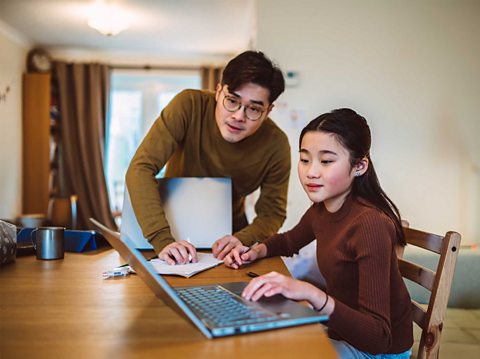What is touch typing?

Touch typing is the skill of being able to type without looking down at the keyboard. Practising typing technique can increase your child's confidence when using a keyboard and develop their muscle memory.
Touch typing can be a difficult skill to master. However, it can sometimes be faster than writing. By regularly practising and by completing typing exercises your child can improve both their typing speed and accuracy.

Why is it important to learn how to touch type?
For children aged 5-11, understanding the keyboard layout is a new skill and challenge. Completing typing activities that use a qwerty keyboard can improve their typing speed and accuracy. This can also be useful when teaching your child to spell or about different letter patterns. To help your child understand and test their knowledge of a keyboard layout of a keyboard, use our 'fill in the missing keys' activity.
For children aged 11-16, knowing how to touch type can also help with note taking and revision. Regularly looking up and down from screen to keyboard can cause typing errors and this can slow down productivity and flow of typing. By practising this skill, students will be able to take notes without interrupting their focus.
Top tips for teaching children to type
Teaching a child to type can change the way they work on a computer. From typing essays to note taking, touch typing can help to give them a boost with spelling, reading and general digital literacy too. To help with practicing regularly, use our free touch typing target tracker to help you get started.
Whilst practising regularly is key to perfecting this skill, there are other tips which can also help.

- Find a comfortable working position: Try sitting up straight with your back against the chair and your feet on the ground. If possible, find support for your wrist and forearm.
- Keep your eyes on the screen: When you are typing, you should try not to look down at your hands. To help, try covering your hands so you aren’t tempted to watch your fingers move.
- Practise your hand positioning: Keep your fingers curved and upright with your thumbs hanging by the space bar.
- Take regular breaks: You should take a rest to relax your hard and arm muscles if you get tired.
Touch typing practise: Play Dance Mat Typing
Put your skills to the test with this Bitesize BBC touch typing game, Dance Mat Typing.
Dance Mat Typing is a game split into four levels of play, each with three stages.
In this game, your child will practise:
- typing letters in rows
- typing keys on the home row
- typing capital letters, apostrophes, slashes and full stops
Each game level will build on previous lessons and introduce new letters as you progress, to give your child plenty of touch typing practise. As you move through each level, use our Dance Mat Typing checklist to track your child's progress.
Play with your child to improve your skills and then test your speed too!
Dance Mat Typing
Learn how to touch type with Dance Mat Typing.

How can touch typing help in a career?
Knowing how to touch type can be a very impressive skill to have, especially when applying for a job. People who are able to touch type can produce work and edit text at a faster speed and often with a greater level of accuracy.
Today there are many jobs that use touch typing to help with tasks. These include:
Journalism and content creation: Whether it's for digital marketing, online news broadcasting, blogging, or technical writing, fast typing skills can boost productivity. Learn more about ‘how to become a journalist’.
Coding and software development: Whilst specific qualifications and programming skills are needed in this role, touch typing can also be an asset for coding efficiently. Learn more about ‘how to become a coder’ and ‘how to become a software developer’.
Transcription work: This job involves listening to audio recordings and writing them up. As such, excellent grammar and spelling, and a fast typing speed are crucial. Transcriptional work can also be a savvy way to make money as a student.
Customer Service Support: Many of these roles involve handling customer queries through live chat support systems. Fast and accurate typing can improve response times and customer satisfaction. Learn more about how to become a customer service apprentice.
Downloadable touch typing activities
You can download the full pack of touch typing activities below. It includes a Dance Mat Typing checklist, a touch typing tracker and a missing keyboard keys activity. Each of these are designed to help your child improve their touch typing skills.
Sign up to the BBC Bitesize newsletter! External LinkSign up to the BBC Bitesize newsletter!
For home education news and stories plus updates on the latest Bitesize content, register for our newsletter today.

